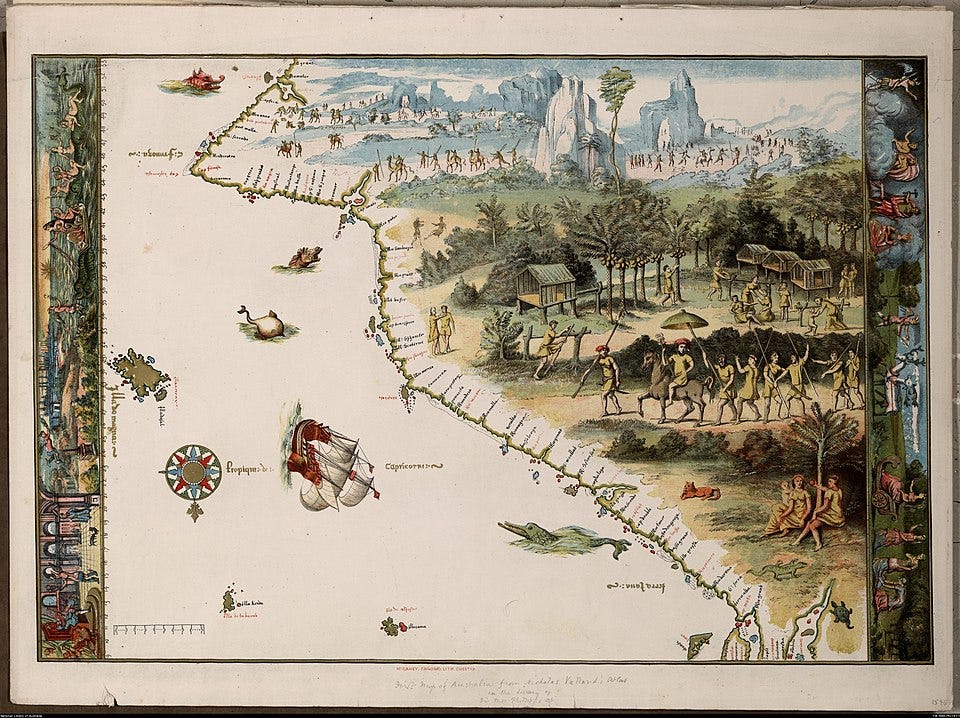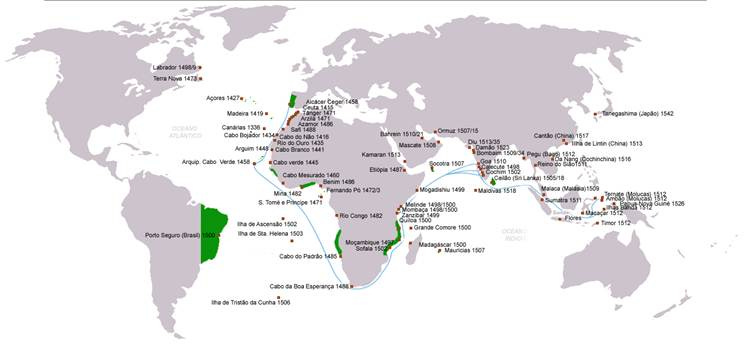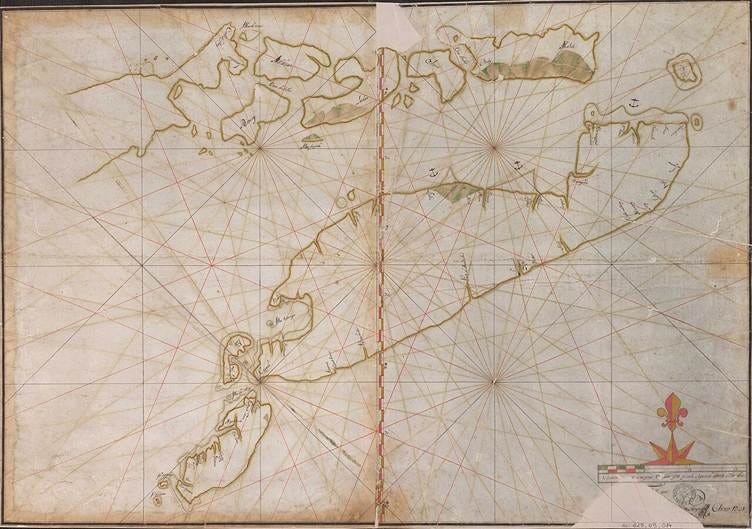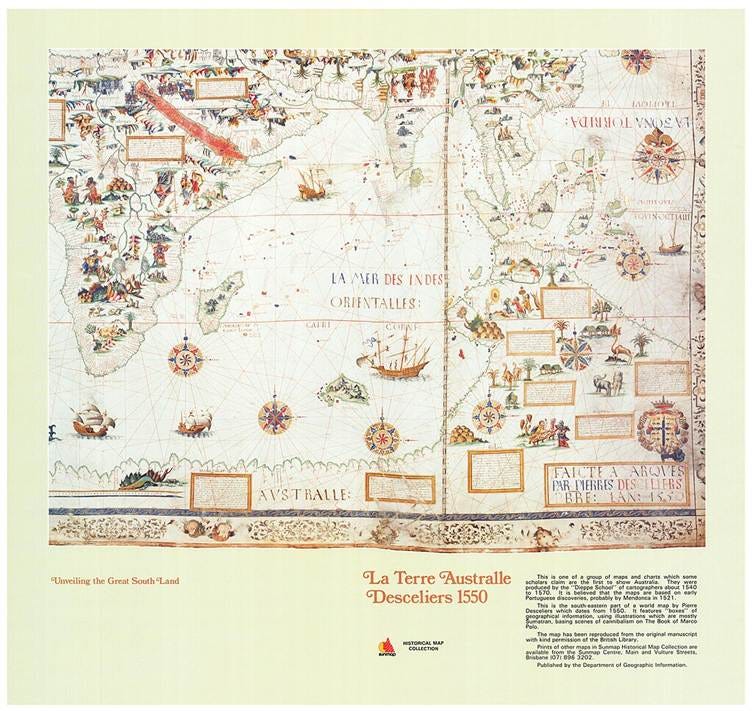FIRST EUROPEANS ARRIVE
This is Part 5 of ‘Who really discovered Australia?’ in which the first Europeans, the Portuguese, arrive in the region. But did they actually discover Australia? Read on …
Jave la Grande's east coast: from Nicholas Vallard atlas, 1547. This is part of an 1856 copy of one of the Dieppe Maps. Copy held by the National Library of Australia.[2] Public Domain, https://commons.wikimedia.org/w/index.php?curid=441641
Become a free or paid subscriber to Michael’s Curious World for full access to reports, to the archive of past writings, and to my ‘Newbies Guide to Substack’, and to help keep the curious journey going. Only $6 a month of $50 a year (a 30% discount).
CONTENTS:
Did the Portuguese discover Australia?
The Dieppe maps
An old theory revived
Relics found in Australia
Did Spain settle Botany Bay?
WERE the Portuguese the first Europeans to discover Australia?
Most experts say no, that was the Dutch in 1606, but there is a significant history of arguing that yes, the Portuguese did get here before other Europeans.
It is even claimed that the Portuguese named the continent Jave la Grande, well before the Spaniard Pedro Fernandes de Queirós, named it La Austrialia del Espiritu Santo: "Austrialia of the Holy Spirit’.
The Portuguese presence in Asia was responsible for what would be the first of many contacts between European countries and the East, starting on May 20, 1498 with the trip led by Vasco de Gama to Callicut in India.
The Portuguese then established trading posts in Ceylon, Malacca, Timor, Macau and other places.
Portuguese discoveries and explorations: first arrival places and dates. By Descobrimentos_e_explorações_portugueses.png: *Portuguese_discoveries_and_explorations.png: *Portuguese_Empire_map.jpg: Toklederivative work: Uxbona (talk) - Descobrimentos_e_explorações_portugueses.png, CC BY-SA 3.0, https://commons.wikimedia.org/w/index.php?curid=6964254
The first Europeans to arrive in the Southeast Asian region were the Portuguese in 1512, landing near modern Pante Macassa.
Dominican friars established the village of Lifau in Timor in 1556 and the first Portuguese settlement in the area was set up on the nearby island of Solor in the 1560s. 1.
Want to read more? Upgrade to paid subscriber for full access.
1731 Portuguese map of Timor. By Antônio E. Brito Freire - http://acervo.bndigital.bn.br/sophia/index.asp?codigo_sophia=33468, Public Domain, https://commons.wikimedia.org/w/index.php?curid=49916450
In 1605, Ambon and Tidore passed to Dutch control, and the following year Ternate was ceded to Spain (before later coming under Dutch control in 1663). The Portuguese capital moved to Flores as the Dutch took control of the western portion of Timor, attracted by the island's large stands of fragrant sandalwood.
The Banda Islands fell to the Dutch in 1621, before Malacca fell in 1641, and Solor shortly afterwards in 1646. The fall of Solor caused the Portuguese capital to be moved again to Kupang on Timor's west, before that was lost again to the Dutch in 1652, and then to Lifau.
In 1702, Antonio Coelho Guerreiro was appointed Governor and Captain General of the islands of Timor and Solor and other regions in the South by Caetano de Melo e Castro the Viceroy of Goa, ending the autonomy of the Dominican missions.
He was sent to Lifau, which became the capital of all Portuguese dependencies in the Lesser Sunda Islands., but Portuguese control over the territory was tenuous, particularly in the mountainous interior, and there was to be a long history of conflict and rebellions.
Did the Portuguese discover Australia?
Selected voyages by Europeans to 1812.
It seems illogical that Portuguese ships could sail so close to Australia and not get blown off course and see this Great Southern Land, as later happened to the Dutch sailing similar routes, as Portuguese Timor is only 650 kilometres from the Australian coast.
Makassans had sent fleets to trade with the Aborigines and Torres Strait Islanders, so the Portuguese could have learned from the Makassans about where those vessels went and what they saw.
The theory of the Portuguese discovery of Australia claims that early Portuguese navigators were the first Europeans to sight Australia between 1521 and 1524.
1. https://www.timorleste.tl/east-timor/about/history/
The Dieppe maps
It is based on the Dieppe maps, a group of 16th-century French world maps, which depict a large landmass between Indonesia and Antarctica, labelled as Java la Grande. 1.
The landmass carries French, Portuguese and Gallicized Portuguese place names, and has been interpreted by some as corresponding to Australia’s northwestern and eastern coasts.
Most proponents of the theory of Portuguese discovery of Australia argued it was Cristóvão de Mendonça who sailed down the eastern Australian coast and provided charts which found their way onto the Dieppe maps, to be included as Jave la Grande in the 1540s - 1560s.
The south eastern section of Map of La Terre Australle Desceliers, showing Portuguese discoveries along the east coast of Australia in the early 1500s.
Richard Henry Mayer, Keeper of Maps at the British Museum, tried in 1859 to prove the Portuguese visited Australia before the Dutch, based on the Dieppe maps.
However, the Portuguese historian Joaquim Pedro de Oliveira Martins concluded that neither the patalie regiã on the 1521 world map of Antoine de La Sale nor the Jave la Grande on the Dieppe Maps was evidence of Australia having been visited by Portuguese visitors in the first quarter of the sixteenth century, but were based on later verbal reports collected from Makassans describing the Java area.
1. https://en.wikipedia.org/wiki/Dieppe_maps
An old theory revived
The revival of the theory of Portuguese discovery of Australia owes much to Melbourne lawyer Kenneth McIntyre’s 1977 book, The Secret Discovery of Australia; Portuguese ventures 200 years before Cook, again based on the Dieppe maps. 1.
McIntyre said Mendonça commanded a voyage to Australia 1521–1524, which had to be kept secret because of the 1494 Treaty of Tordesillas which divided the undiscovered world into two-halves for Portugal and Spain, with Portugal to control the eastern routes to Asia that went around Africa while the Spanish were to come from the Americas across the Pacific.
He argued the distorted shape of the continent was explained by errors in calculating latitude and longitude.
Jave la Grande on the Harleian Mappemonde, as illustrated in Ernest Favenc, The history of Australian exploration from 1788 to 1888, London & Sydney, Griffith, Farran, Okeden & Welsh, Turner & Henderson, 1888. By Open to conjecture - Scan at archive,org, Public Domain, https://commons.wikimedia.org/w/index.php?curid=9526118
1. https://en.wikipedia.org/wiki/Theory_of_the_Portuguese_discovery_of_Australia
Relics found in Australia
Various antiquities found on Australian coastlines are claimed by some to be relics of early Portuguese voyages to northern Australia, but are more generally regarded as evidence of Makassan visits.
McIntyre referred to The Mahogany Ship, an early Australian shipwreck that is believed by some to lie beneath the sand in the Armstrong Bay area, about 3 to 6 kilometres west of Warnambool in southwest Victoria, described by McIntyre as a Spanish or Portuguese caravel.
He referenced nineteenth-century accounts of the relic, including an 1847 newspaper article, but recent research has questioned this theory and provided other explanations.
Another piece of evidence is known as The Geelong Keys, a set of five keys discovered in 1847 at Limeburners Point on the southern shore of Corio Bay near Geelong, which some have suggested may have been Portuguese, although there are other explanations.
Neither the Portuguese explorer Ferdinand Magellan nor the English Francis Drake, who became the first two to circumnavigate the globe from the Americas to Southeast Asia and Africa, realised how tantalisingly close they had come to the elusive Great Southern Land.
Did Spain settle Botany Bay?
The Spanish were certainly active in the region, with their settlement of The Philippines, as we shall see in a future part of this series.
However, there is general agreement that the Dutch, and possibly the Portuguese, beat them to be the first Europeans to reach the southern continent.
Nevertheless, I shall just mention here a rather bizarre and generally discredited theory about the Spanish and Botany Bay.
In the early 20th century, Lawrence Hargrave unconvincingly argued that Spain had established a colony in Botany Bay in the 16th century. 1.
Five coins from the Kilwa Sultanate were found on Marchinbar Island in the Wessel Islands in 1945 by RAAF radar operator Morry Isenberg.
In 2018 another coin, also thought to be from Kilwa, was found on a beach on Elcho Island, another of the Wessel Islands, by archaeologist and member of the Past Masters, Mike Hermes.
Hermes speculated that the coins may suggest trade between indigenous Australians and Kilwa, or may have arrived via Makassan contact with Australia.
Mike Owen, another member of the Past Masters group speculated that these coins may have arrived sometime after they had installed Muhammad Arcone on the Kilwa throne as a Portuguese vassal, from 1505 to 1506, or that the Portuguese had visited Wessel islands.
NEXT: We meet the first European confirmed to have reached Australia - and no, it wasn’t Captain James Cook.
1. https://en.wikipedia.org/wiki/European_maritime_exploration_of_Australia









